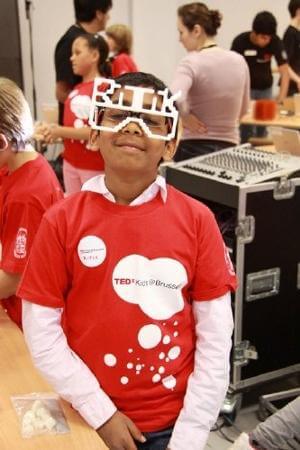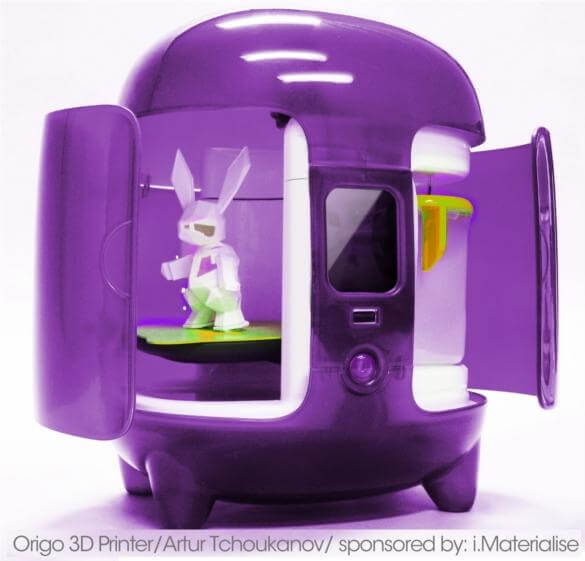Origo’s 3D Printer Could Be The Last Toy Your Ten Year Old Will Ever Need

Share
Origo may be the last toy you ever have to buy for your child. The prototype 3D printer under development by Artur Tchoukanov and Joris Peels allows children aged ten and up to design figurines and shapes on a computer, and then print them out to play with. Instead of buying your children more toys, let them make their own. Check out the incredible idea behind Origo in the concept video below.
I recently had a chance to correspond with Peels. He tells me that Origo is talking with angel investors and hopefully 18 months from launch. Though Tchoukanov and Peels have a lot of work ahead of them if they want to make Origo a reality, the promise of this concept makes so much sense that it warrants serious attention. Early testing at TEDxKids in Brussels suggests that children are dying to print their own stuff. Where was 3D printing when I was kid, huh?
Origo's concept video is very basic, but it gives you a good idea of what Tchoukanov and Peels hope to accomplish. A simple interface allows children to digitally design a shape, and then the Origo printer creates it in an hour or so (depends a lot on size and complexity). A machine that takes your dreams and turns them into real world objects - what child wouldn't want this thing?
Origo is still in the prototype phase, but its creators have openly discussed some of the ultimate specs on their Twitter feed and Facebook page, as well as on their main site. We should expect the 3D printer to have a USB port, wireless connectivity, a price around $800, and it will use 3Dtin as its design software. Peels tells me that the printer will be able to produce objects about the size of a "large mug or medium jar." Depending on complexity, Origo should be able to give kids a small object (like a ring) in a manner of minutes, but larger objects (like a detailed baseball) could take a few hours. Material costs for 3D printing are high (say $40 to $400 a kilo for plastic!) but Peels really wants to bring this down to something very reasonable. He couldn't go into details as to how Origo will accomplish this, but he was confident it could be done. They are also looking at including a "recycling pod" with Origo so that old objects can be broken down and reused to print new ones. Peels hopes that cheaper materials will lead to Origo being adopted by a large number of households, disrupting both the toy industry and the 3D printing industry in one blow. They aim to sell directly from their website and through several partnered retailers.
Now, clearly some of what Peels and Tchoukanov hope to accomplish has been done before to different degrees. Desktop 3D printers are already here, and small companies are already making their impact. One of my favorite 3D printers is from MakerBot. In fact, their open source printers have been so successful that they've garnered the startup $10 million in funding. So what makes Origo different? Well, the cheapest you'll get a MakerBot printer is around $1300, and that involves you doing most of the assembly. Origo will come completely ready to go for $800, and is dedicated to being very kid/home friendly: quiet, non-toxic, child-safe, etc. Now, with just a prototype, it's not clear on how much of their promises Origo will be able to deliver on. But even a partial success for Origo may allow them to claim this niche in the 3D market easily. For while kids can use MakerBot and other 3D printers currently on the market, these products simply aren't designed with children in mind.
Origo will be. I think one of the cornerstones of Origo's possible success is Tchoukanov and Peels' choice to leverage 3Dtin. For those who haven't used the program before, it's a very simple interface that allows you to create 3D shapes out of virtual blocks. Most 3D software out there is really hard to learn and mysterious to the uninitiated. Not so with 3Dtin. With minimal instruction (there are some great online tutorials) you can start designing almost anything you can imagine out of the primary colored virtual blocks. (Peels tells me that simple rules like "don't make anything thinner than two blocks" keep kids from designing things that won't print well.) 3Dtin then exports the object you created into one of several commonly used 3D file formats. It's not the most versatile 3D design software out there, but it certainly is one of the easiest to use. I'd tell you to go and try 3Dtin right now, but then you would never come back to read the rest of this article. It's that fun and addictive to play with.
That's something that the Origo team knows well. During the latest TEDxKids event in Brussels, Peels and a few colleagues taught 56 ten years olds how to use 3Dtin, and then helped them print out what they had created in the virtual interface. The results where dozens of cool objects, and a bunch of really excited children. Now, the 3D printers used were commercial grade, not the Origo prototype, but this little experiment proved the Origo equation will work. Easy design interface + 3D printing = excited and engaged children creating their own fun.
Be Part of the Future
Sign up to receive top stories about groundbreaking technologies and visionary thinkers from SingularityHub.


Peels also revealed to me that what children want from 3D printing may be counter-intuitive. Some of the most desired objects kids want to create are headphones, customized gifts, display objects, and accessories. Peels stressed that children are sold "toys" but what they create is more innovative and useful than mere playthings. It's possible that training children on a platform like Origo may help create a generation that is more interested in custom building their small goods than purchasing them. Certainly Peels thinks that 3D printing is a gateway to a better mode of consuming and a technology we should get children interested in now:
"If you make what you want exactly as you want it to be, those things will be of higher value to you than the mass produced crap that dominates our world. With 3D printing you can make something that fits your body precisely, or a gift that fits the occasion precisely. You can make something for one person, you. This is where the true promise of 3D printing lies, to let us escape mass production and make the things that we really want. 3D printing closes the resolution gap between the imagination and reality. It is a wish fulfillment technology. It is our hope that by closing the gap between kids' imaginations and the things they can make they will partially lose interest in mass produced items and they will help push back mass production."
---Joris Peels, October 2011
Tchoukanov and Peels are still very early in their journey to bring Origo to life, but they have some firm credentials that may help get them there. Tchoukanov started Origo as his master's thesis at the prestigious Umea Institute of Design in Sweden, and interned at Shapeways (a 3D printing company we've covered before). Meanwhile, Peels was the Commmunity Manager of both i.materialise (a 3D printing service) and Shapeways. They aren't quite superstars of the 3D printing world, but they do know a lot about how it works. And who knows, maybe Origo will make them superstars.
I'm certainly rooting for Origo, and it would be a shame if they don't get off the ground in the next 18 months or so. There are many hurdles, not the least of which is taking a prototype and turning it into a platform that only costs $800, but that does much of what devices twice its cost can do. That's going to be difficult. If I'm being honest, it may be impossible. But these guys are very committed, smart, dedicated to their vision, and have a working prototype. You really can't ask for more than that.
Of course, whether or not Origo succeeds, the greater shame would be if their idea didn't get the attention it deserves. Children and simplified 3D printing are an awesome combination. I hope that MakerBot, Stratasys, Objet and other 3D printing companies are looking at this concept and seeing the possibilities. A desktop 3D printer that was stripped down to fit a price tag less than $1000 and that came with a simplified design suite would be a killer product. Good luck to Origo in making that dream come true, but kudos to anyone that can make it happen.
...and a billion points to anyone who sends such a product back in time to my 10 year old self. I would have given up Legos for a 3D printer like this! (<---I can think of no greater praise.)
[image credits: Origo]
[video credit: Umea Institute of Design]
[source: Origo, Joris Peels via email]
Related Articles

This Portable Wind Turbine Is the Size of a Water Bottle and Charges Devices in Under an Hour

Mojo Vision’s New Contact Lens Brings Seamless Augmented Reality a Step Closer
The Weird, the Wacky, the Just Plain Cool: Best of CES 2020
What we’re reading



